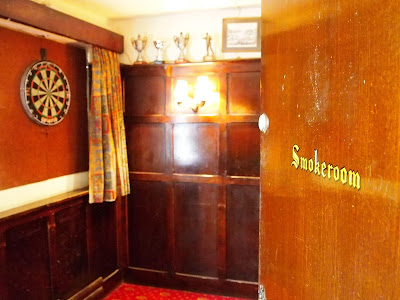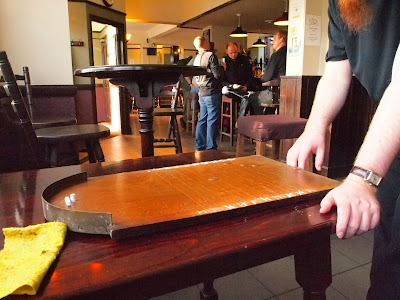
The
Shove Ha'penny Board shown here was a recent inexpensive acquisition from a vintage stall in Gloucestershire. No information on its origin was forthcoming from the dealer, which is a shame but usually the case.
At first glance it appears to be little more than a cheap homemade board, very similar in appearance to another inexpensive board which has
already featured on this blog. Both are constructed from three planks of tongue and groove timber, and both have a similar three piece end stop arrangement. In fact the timbers are thinner and longer on this board, and it's probably made from a better quality hardwood, but nevertheless, the design is essentially identical.
The main difference between the two boards, and what makes this one slightly more interesting than most, is only noticeable on closer examination of the edges and underside.
The stamped mark shown above can be found on one edge of the playing surface, and seems to me to represent most of the lettering of London games manufacturer
Jaques. As you can see, there is more lettering above this, but it's position on the very edge of the board makes it too indistinct to read. If we assume this
is a Jaques board, it suggests that the company would have made a whole range of different models, from their usual top of the range Mahogany and Brass boards, down to this cheaper, more workmanlike version. Interesting? Well maybe not. Jaques have been around for a very long time, so it's hardly surprising they would have made numerous different models for different markets. There may have been another explanation for a cheaper model like this though, which brings me to the other, much clearer mark located on the bracing baton underneath.
The symbol shown on this image appears to be a Government property stamp with an associated number 56, the purpose of which is not entirely clear but could have been a stores number. Known as a
Broad Arrow, this mark was stamped onto all manner of items, military issue equipment and sundries in particular. At first it might seem strange to find a government property mark on a Shove Ha'penny board, but in fact the game seems to have been very popular, and very widely played in the forces at one time. Not only have I seen one or two supposed ex-RAF Shove Ha'penny boards for sale online (for appropriately sky-high prices it must be said), but there are also several photographs from the second world war era showing RAF personnel playing the game as a way to relax between missions (see
here and
here for example).
Quite whether this board is ex-military issue, or for how long the government would have continued to list Shove Ha'penny boards in its extensive store inventory is hard to say. My best guess is that this board formed part of an order placed by the government to Jaques of London, possibly some time around the second world war. Perhaps this was a special 'war standard' Shove Ha'penny, explaining the cheap and cheerful construction of the board by a company usually noted for the high quality of its numerous games.
Update (23/09/13) - I've now had confirmation from Jaques that this board was indeed a government issue Shove Ha'penny, dating from some time around the second world war. The board will now be joining Jaques own games collection.
Pushpenny
The
Pushpennys shown here include a small homemade board (
left) which is now part of the fixtures and fittings of
The George in Ashley, Northamptonshire. The larger board (
right) came in a job lot of junk at an agricultural auction in Melton Mowbray. It was in very poor condition, missing its end-stop, and as can be seen in the image below, had suffered from the attentions of Wood Boring Beetle at some point. I thought it was worth a few quid and set about treating and restoring it to active service. Although similar in most regards to a classic Stamford Pushpenny board, there are a couple of crucial differences likely to preclude this board from serious league play.

The playing surface of a Pushpenny Board is usually made from a tight grained hardwood such as Mahogany, sometimes with a softer wood used for the scoring and end pieces. The board shown here is unusual in that the timber for the playing surface is a fairly smooth softwood (possibly Pitch Pine), with a deep brown, tight grained hardwood used for the scoring strips. A matching piece of hardwood also forms the start of the playing surface. A good deal of work has gone into the construction of this board, including beautifully inlaid hardwood strips to mark each of the nine beds, so it's perhaps surprising that a more suitable wood wasn't chosen in the first place for the playing surface. After some work with fine sandpaper and steel wool, the playing surface has come up to be quite smooth, but I don't think it will ever be as 'fast' as a hardwood board. Maybe it needs a bit more work, or maybe it will get better with a bit of play. It's also worth mentioning that the spacings on this board are a little wider than other Stamford boards I've seen.

 |
| Detail of the end stop and side bars on the Pushpenny Board at the George, Ashley. |
 There seems to be an increasing number of pubs where the Darts Board has been unceremoniously ousted from the bar, often in favour of an extra table for dining, or simply because a Darts Board just doesn't fit with the clean, bland lines of the most recent off-the-peg refurbishment. I must say, I find it hard to warm to a pub without a Darts Board. Removing a sociable game like Darts from the bar seems to send out the message that customers are welcome to eat and spend, but the old-fashioned pastimes of social drinking and games play are not what this pub is about. That's not my kind of pub, and in many cases it pushes the limits of what I consider a pub to be!
There seems to be an increasing number of pubs where the Darts Board has been unceremoniously ousted from the bar, often in favour of an extra table for dining, or simply because a Darts Board just doesn't fit with the clean, bland lines of the most recent off-the-peg refurbishment. I must say, I find it hard to warm to a pub without a Darts Board. Removing a sociable game like Darts from the bar seems to send out the message that customers are welcome to eat and spend, but the old-fashioned pastimes of social drinking and games play are not what this pub is about. That's not my kind of pub, and in many cases it pushes the limits of what I consider a pub to be! The Olde Hare & Hounds in the village of Anstey, Leicestershire, features regular quiz nights, and is a real hotbed of local rugby support. It's also a thoroughly traditional local, and features the traditional gaming interests of Darts, Dominoes, and Cribbage. The Ladies Darts Team play in the Whitwick Winter League, whilst the men play a mostly social game on Tuesday evenings. In-house competition includes the coveted Duck Award for an individual who has failed to win any matches throughout the season!
The Olde Hare & Hounds in the village of Anstey, Leicestershire, features regular quiz nights, and is a real hotbed of local rugby support. It's also a thoroughly traditional local, and features the traditional gaming interests of Darts, Dominoes, and Cribbage. The Ladies Darts Team play in the Whitwick Winter League, whilst the men play a mostly social game on Tuesday evenings. In-house competition includes the coveted Duck Award for an individual who has failed to win any matches throughout the season!






































